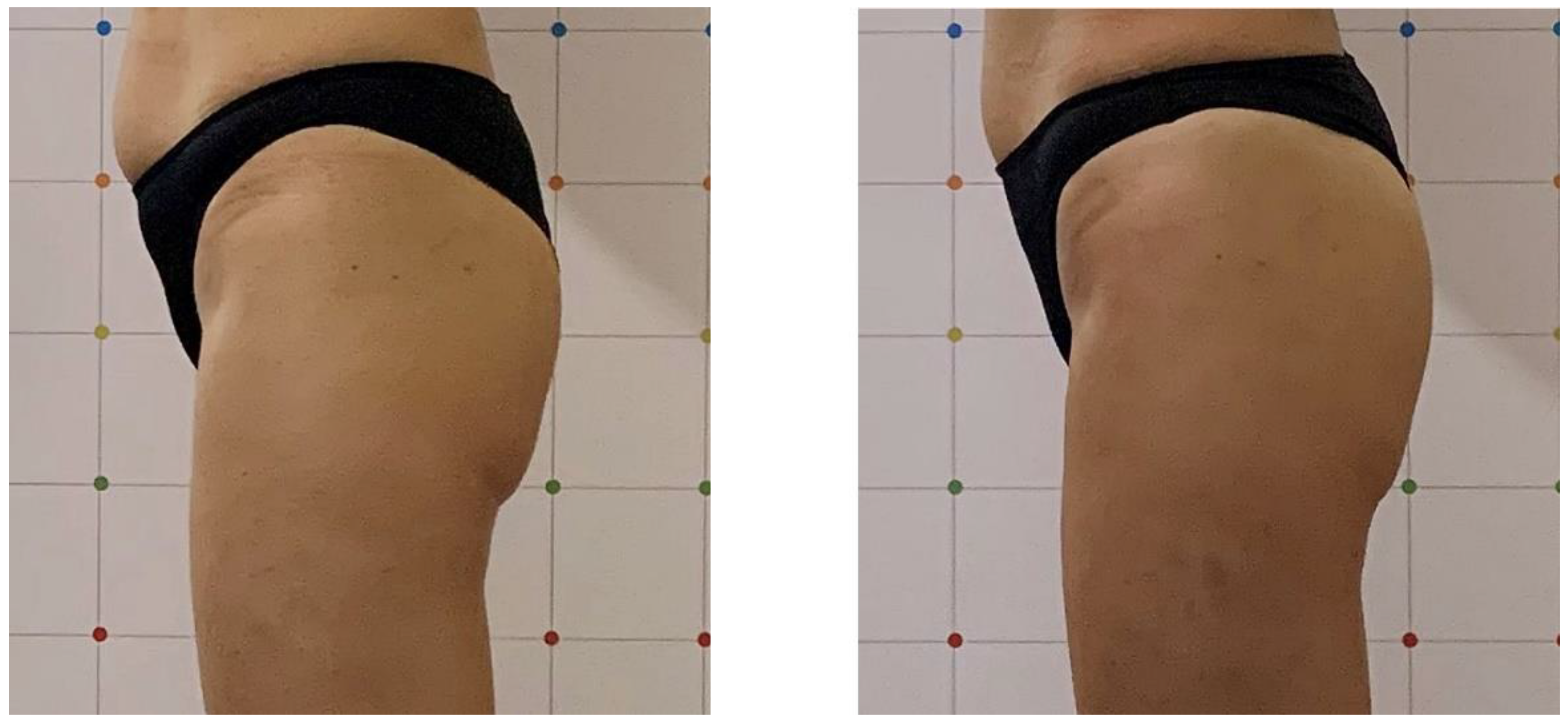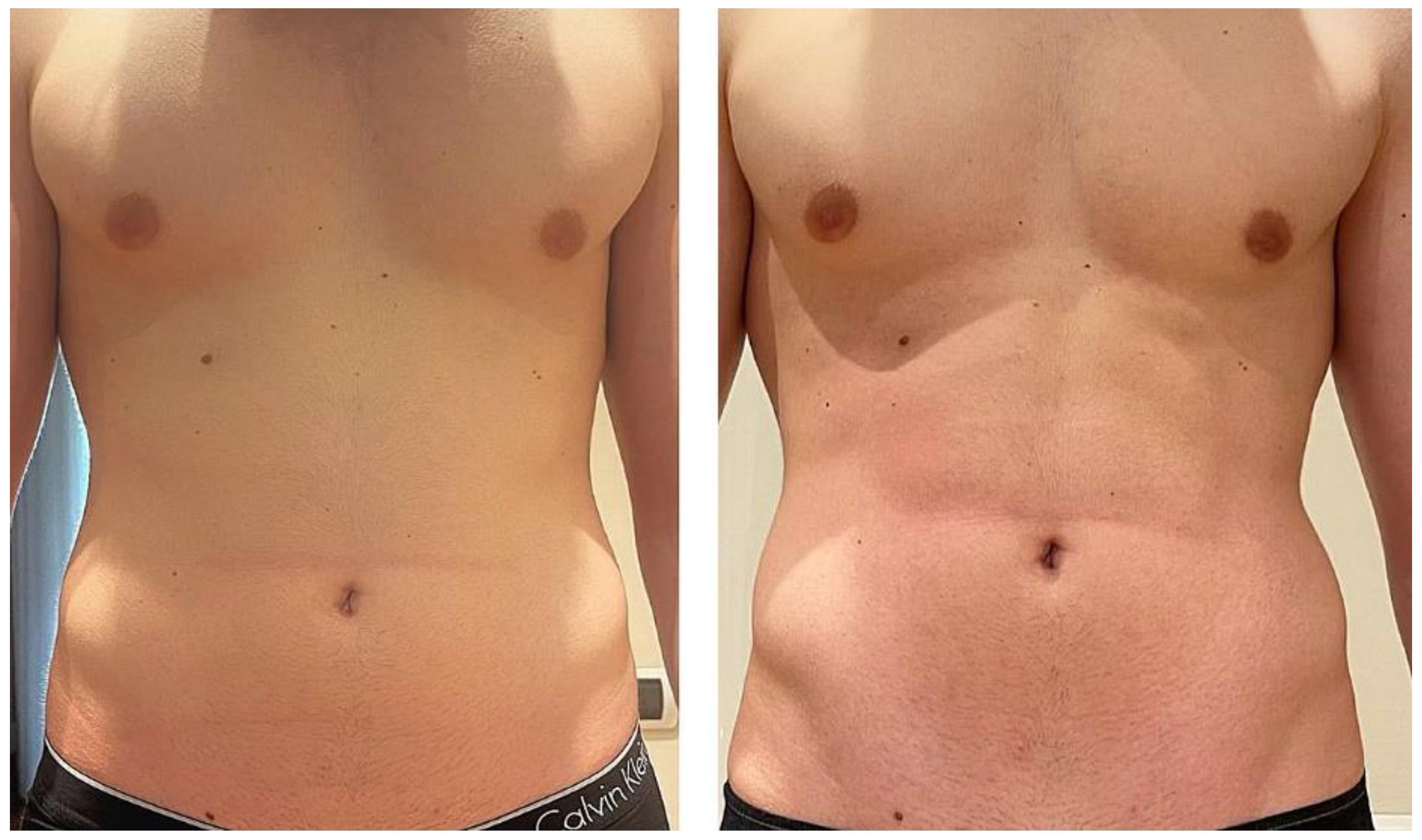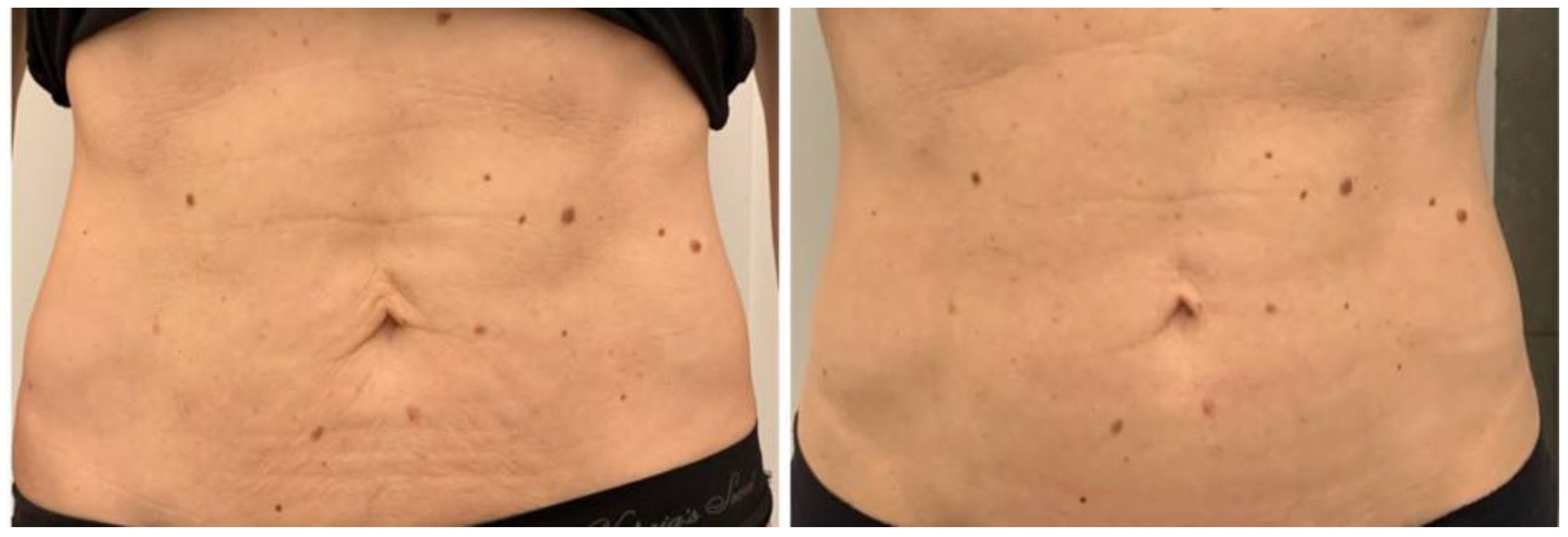Is It Possible to Reshape the Body and Tone It at the Same Time? Schwarzy: The New Technology for Body Sculpting
Abstract
:1. Introduction
2. Materials and Methods
2.1. Patient Selection
2.2. Study Protocols
2.3. Statistical Analysis
3. Results
4. Discussion
Study Limitations
5. Conclusions
Author Contributions
Funding
Institutional Review Board Statement
Informed Consent Statement
Data Availability Statement
Conflicts of Interest
References
- Neeland, I.J.; Ross, R.; Després, J.-P.; Matsuzawa, Y.; Yamashita, S.; Shai, I.; Seidell, J.; Magni, P.; Santos, R.D.; Arsenault, B.; et al. Visceral and ectopic fat, atherosclerosis, and cardiometabolic disease: A position statement. Lancet Diabetes Endocrinol. 2019, 7, 715–725. [Google Scholar] [CrossRef]
- Mulligan, S.E.; Fleck, S.J.; Gordon, S.E.; Koziris, L.P. Influence of resistance exercise volume on serum growth hormone and cortisol concentrations in women. J. Strength Cond. Res. 1996, 10, 256–262. [Google Scholar]
- Kraemer, W.J.; Häkkinen, K.; Newton, R.U.; Nindl, B.C.; Volek, J.S.; McCormick, M.; Gotshalk, L.A.; Gordon, S.E.; Fleck, S.J.; Campbell, W.W.; et al. Effects of heavy-resistance training on hormonal response patterns in younger vs. older men. J. Appl. Physiol. 1999, 87, 982–992. [Google Scholar] [CrossRef] [PubMed] [Green Version]
- Vierck, J.; O’Reilly, B.; Hossner, K.; Antonio, J.; Byrne, K.; Bucci, L.; Dodson, M. Satellite cell regulation following myotrauma caused by resistance exercise. Cell Biol. Int. 2000, 24, 263–272. [Google Scholar] [CrossRef] [PubMed]
- Toigo, M.; Boutellier, U. New fundamental resistance exercise determinants of molecular and cellular muscle adaptations. Eur. J. Appl. Physiol. 2006, 97, 643–663. [Google Scholar] [CrossRef] [Green Version]
- Kennedy, J.; Verne, S.; Griffith, R.; Falto-Aizpurua, L.; Nouri, K. Non-invasive subcutaneous fat reduction: A review. J. Eur. Acad. Dermatol. Venereol. 2015, 29, 1679–1688. [Google Scholar] [CrossRef]
- Langeard, A.; Bigot, L.; Chastan, N.; Gauthier, A. Does neuromuscular electrical stimulation training of the lower limb have functional effects on the elderly? A systematic review. Exp. Gerontol. 2017, 91, 88–98. [Google Scholar] [CrossRef]
- Matsuse, H.; Hashida, R.; Takano, Y.; Omoto, M.; Nago, T.; Bekki, M.; Shiba, N. Walking Exercise Simultaneously Combined with Neuromuscular Electrical Stimulation of Antagonists Resistance Improved Muscle Strength, Physical Function, and Knee Pain in Symptomatic Knee Osteoarthritis: A Single-Arm Study. J. Strength Cond. Res. 2017, 31, 171–180. [Google Scholar] [CrossRef]
- Alon, G.; McCombe, S.A.; Koutsantonis, S.; Stumphauzer, L.J.; Burgwin, K.C.; Parent, M.M.; Bosworth, R.A. Comparison of the effects of electrical stimulation and exercise on abdominal musculature. J. Orthop. Sports Phys. 1987, 8, 567–573. [Google Scholar] [CrossRef] [Green Version]
- Lambert, H.; Baetselier, E.D.; Vanalme, G.; Mey, G.D. Skin burn risks using transcutaneous direct current. In Proceedings of the IEEE Engineering Medicine and Biology 17th Annual Conference, Montreal, QC, Canada, 20–23 September 1995; pp. 647–648. [Google Scholar]
- Han, T.R.; Shin, H.I.; Kim, I.S. Magnetic stimulation of the quadriceps femoris muscle: Comparison of pain with electrical stimulation. Am. J. Phys. Med. Rehabil. 2006, 85, 593–599. [Google Scholar] [CrossRef]
- Mulholland, R.S.; Paul, M.D.; Chalfoun, C. Noninvasive body contouring with radiofrequency, ultrasound, cryolipolysis, and low-level laser therapy. Clin. Plast. Surg. 2011, 38, 503–520. [Google Scholar] [CrossRef] [PubMed]
- Rossi, S.; Hallett, M.; Rossini, P.M.; Alvaro, P.L. Safety, ethical considerations, and application guidelines for the use of transcranial magnetic stimulation in clinical practice and research. Clin. Neurophysiol. 2009, 120, 2008–2039. [Google Scholar] [CrossRef] [PubMed] [Green Version]
- Yokoyama, T.; Fujita, O.; Nishiguchi, J.; Nozaki, K.; Nose, H.; Inoue, M.; Ozawa, H.; Kumon, H. Extracorporeal magnetic innervation therapy for stress urinary incontinence. Urology 1999, 53, 1108–1111. [Google Scholar]
- Mazzoni, D.; Lin, M.J.; Dubin, D.P.; Khorasani, H. Review of non-invasive body contouring devices for fat reduction, skin tightening and muscle definition. Australas. J. Dermatol. 2019, 60, 278–283. [Google Scholar] [CrossRef] [PubMed]
- Makarov, S.; Bogdanov, G.; Noetscher, G.; Appleyard, W.; Ludwig, R.; Joutsa, J.; Deng, Z.-D.; Makarov, S.; Horner, M.; Noetscher, G. Design and Analysis of a Whole-Body Noncontact Electromagnetic Subthreshold Stimulation Device with Field Modulation Targeting Nonspecific Neuropathic Pain. In Brain and Human Body Modeling: Computational Human Modeling at EMBC 2018; Springer: Cham, Switzerland, 2019; Chapter 5. [Google Scholar]
- Mezzana, P.; Pieri, L.; Leone, A.; Fusco, I. Schwarzy: The new system for muscle toning and body shaping. J. Cosmet. Dermatol. 2021, 20, 2678–2680. [Google Scholar] [CrossRef]
- Katz, B.; Bard, R.; Goldfarb, R.; Shiloh, A.; Kenolova, D. Ultrasound Assessment of Subcutaneous Abdominal Fat Thickness After Treatments with a High-Intensity Focused Electromagnetic Field Device: A Multicenter Study. Clin. Trial Dermatol. Surg. 2019, 45, 1542–1548. [Google Scholar] [CrossRef]
- Duncan, D.; Dinev, I. Noninvasive Induction of Muscle Fiber Hypertrophy and Hyperplasia: Effects of High-Intensity Focused Electromagnetic Field Evaluated in an In-Vivo Porcine Model: A Pilot Study. Aesthet. Surg. 2020, 5, 568–574. [Google Scholar] [CrossRef]
- Samuels, J.B.; Katz, B.; Weiss, R.A. Radiofrequency Heating and High-Intensity Focused Electromagnetic Treatment Delivered Simultaneously: The First Sham-Controlled Randomized Trial. Plast. Reconstr. Surg. 2022, 149, 893e–900e. [Google Scholar] [CrossRef]
- Alexiades, M. High Intensity Focused Electromagnetic Field (HIFEM) Devices in Dermatology. J. Drugs Dermatol. 2019, 18, 1088. [Google Scholar]
- Stallknecht, B.; Dela, F.; Helge, J.W. Are blood flow and lipolysis in subcutaneous adipose tissue influenced by contractions in adjacent muscles in humans. Am. J. Physiol. Endocrinol. Metab. 2007, 292, e39409. [Google Scholar] [CrossRef] [Green Version]
- Kinney, B.M.; Lozanova, P. High intensity focused electromagnetic therapy evaluated by magnetic resonance imaging: Safety and efficacy study of a dual tissue effect based noninvasive abdominal body shaping. Lasers Surg. Med. 2018, 51, 40–46. [Google Scholar] [CrossRef] [PubMed] [Green Version]
- Giesse, S. Prospective Study of the Safety and Efficacy of a Non-Invasive, High-intensity, Electromagnetic Abdomen and Buttock Contouring Device. J. Clin. Aesthet. Dermatol. 2021, 14, 30–33. [Google Scholar]
- Jacob, C.I.; Paskova, K. Safety and efficacy of a novel highintensity focused electromagnetic technology device for noninvasive abdominal body shaping. J. Cosmet. Dermatol. 2018, 17, 783–787. [Google Scholar] [CrossRef] [Green Version]
- Jacob, C.; Kinney, B.; Busso, M.; Chilukuri, S.; McCoy, J.D.; Bailey, C.; Denkova, R. High intensity focused electromagnetic technology (HIFEM) for non-invasive buttock lifting and toning of Gluteal muscles: A multi-centre efficacy and safety study. J. Drugs Dermatol. 2018, 17, 1229–1232. [Google Scholar] [PubMed]
- Kinney, B.M.; Kent, D.E. MRI and CT Assessment of Abdominal Tissue Composition in Patients After High-Intensity Focused Electromagnetic Therapy Treatments: One-Year Follow-Up. Aesthet. Surg. J. 2020, 40, 686–693. [Google Scholar] [CrossRef]
- Katz, B. MRI Assessment of Arm and Calf Muscle Toning with High-Intensity Focused Electromagnetic Technology: Case Study. Case Rep. J. Drugs Dermatol. 2020, 19, 556–558. [Google Scholar] [CrossRef]
- Gwinn, C.; Spring, L.; Tanzi, E.; Dover, J.S. Muscle Toning and Strengthening Through Electromagnetic Stimulation and Direct Current. Adv. Cosmet. Surg. 2021, 4, 1–7. [Google Scholar] [CrossRef]
- Kent, D.E.; Carolyn, I.J. Simultaneous Changes in Abdominal Adipose and Muscle Tissues Following Treatments by High-Intensity Focused Electromagnetic (HIFEM) Technology-Based Device: Computed Tomography Evaluation. Clin. Trial J. Drugs Dermatol. 2019, 18, 1098–1102. [Google Scholar]
- Leone, A.; Piccolo, D.; Conforti, C.; Pieri, L.; Fusco, I. Evaluation of safety and efficacy of a new device for muscle toning and body shaping. J. Cosmet. Dermatol. 2021, 20, 3863–3870. [Google Scholar] [CrossRef]
- Nisticò, S.P.; Bonan, P.; Coli, F.; Verdelli, A.; Fusco, I.; Gratteri, F.; Sicilia, C.; Cantisani, C.; Pellacani, G.; Bennardo, L.; et al. A New Protocol to Treat Abdominal Subcutaneous Fat Combining Microwaves and Flat magnetic stimulation. Bioengineering 2022, 9, 182. [Google Scholar] [CrossRef]
- Valdivia, R. Abdominal body shaping using StarFormer high-intensity magnetic stimulation—A case series. J. Cosmet. Dermatol. 2022, 21, 2021–2025. [Google Scholar] [CrossRef] [PubMed]
- Fabi, S.; Dover, J.S.; Tanzi, E.; Bowes, L.E.; Ms, F.T.F.; Odusan, A. A 12-Week, Prospective, Non-Comparative, Non-Randomized Study of Magnetic Muscle Stimulation for Improvement of Body Satisfaction with the Abdomen and Buttocks. Lasers Surg. Med. 2020, 53, 79–88. [Google Scholar] [CrossRef] [PubMed]





| Question (Score Range, 1–7) | Baseline Mean | 1 M FU Mean | Significance | Change |
|---|---|---|---|---|
| Please rate your subjective perception of your buttock laxity/tightness | ||||
| Total (n = 24) | 2.8 ± 1.6 | 4.1 ± 0.9 | (p < 0.01) | 1.4 |
| Am I satisfied with the overall aesthetic appearance of my buttocks? | ||||
| Total (n = 24) | 2.4 ± 1.2 | 5.1 ± 1.4 | (p < 0.01) | 2.8 |
| I am satisfied with the shape of my buttocks? | ||||
| Total (n = 24) | 2.8 ± 1.6 | 3.9 ± 1.5 | (p < 0.01) | 1.1 |
| Do I feel confident about my buttocks area when wearing a swimsuit? | ||||
| Total (n = 24) | 2.6 ± 1.4 | 3.4 ± 1.3 | (p < 0.05) | 0.8 |
| Total score | 10.5 ± 1.9 | 16.6 ± 2.7 | (p < 0.01) | 6.0 |
| Question (Score Range, 1–7) | Baseline Mean | 1 M FU Mean | Significance | Change |
|---|---|---|---|---|
| Please rate your subjective perception of your abdomen laxity/tightness | ||||
| Total (n = 25) | 3.6 ± 1.3 | 4.1 ± 0.9 | (p < 0.05) | 0.6 |
| Am I satisfied with the overall aesthetic appearance of my abdomen? | ||||
| Total (n = 25) | 2.8 ± 1.6 | 5.4 ± 1.3 | (p < 0.01) | 2.6 |
| Am I satisfied with the shape of my abdomen? | ||||
| Total (n = 25) | 3.1 ± 1.6 | 4.2 ± 1.5 | (p < 0.05) | 1.1 |
| Do I feel confident about my abdomen area when wearing a swimsuit? | ||||
| Total (n = 25) | 3.4 ± 1.7 | 4.0 ± 1.3 | (p < 0.05) | 0.6 |
| Total score | 12.8 ± 3.1 | 17.7 ± 2.6 | (p < 0.01) | 4.9 |
| Buttock Circumference | Mean ± SD [cm] | Significance |
|---|---|---|
| Pretreatment | 85.5 ± 0.7 | p < 0.05 |
| Posttreatment (1 M FU) | 88.5 ± 0.7 | |
| Change [cm] | 3.0 |
| Abdomen Circumference | Mean ± SD [cm] | Significance |
|---|---|---|
| Pretreatment | 76.5 (±9.19) | p < 0.05 |
| Posttreatment (1 M FU) | 78 (±9.89) | |
| Change [cm] | 1.5 |
Publisher’s Note: MDPI stays neutral with regard to jurisdictional claims in published maps and institutional affiliations. |
© 2022 by the authors. Licensee MDPI, Basel, Switzerland. This article is an open access article distributed under the terms and conditions of the Creative Commons Attribution (CC BY) license (https://creativecommons.org/licenses/by/4.0/).
Share and Cite
Negosanti, F.; Cannarozzo, G.; Zingoni, T.; Leone, A.; Fusco, I. Is It Possible to Reshape the Body and Tone It at the Same Time? Schwarzy: The New Technology for Body Sculpting. Bioengineering 2022, 9, 284. https://doi.org/10.3390/bioengineering9070284
Negosanti F, Cannarozzo G, Zingoni T, Leone A, Fusco I. Is It Possible to Reshape the Body and Tone It at the Same Time? Schwarzy: The New Technology for Body Sculpting. Bioengineering. 2022; 9(7):284. https://doi.org/10.3390/bioengineering9070284
Chicago/Turabian StyleNegosanti, Francesca, Giovanni Cannarozzo, Tiziano Zingoni, Alessandro Leone, and Irene Fusco. 2022. "Is It Possible to Reshape the Body and Tone It at the Same Time? Schwarzy: The New Technology for Body Sculpting" Bioengineering 9, no. 7: 284. https://doi.org/10.3390/bioengineering9070284
APA StyleNegosanti, F., Cannarozzo, G., Zingoni, T., Leone, A., & Fusco, I. (2022). Is It Possible to Reshape the Body and Tone It at the Same Time? Schwarzy: The New Technology for Body Sculpting. Bioengineering, 9(7), 284. https://doi.org/10.3390/bioengineering9070284





